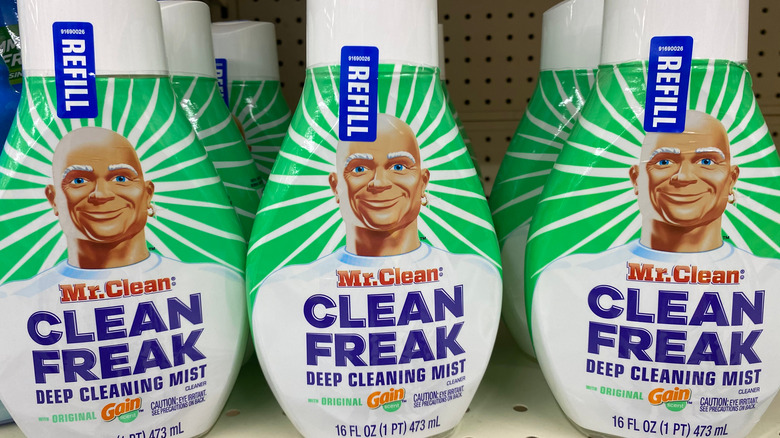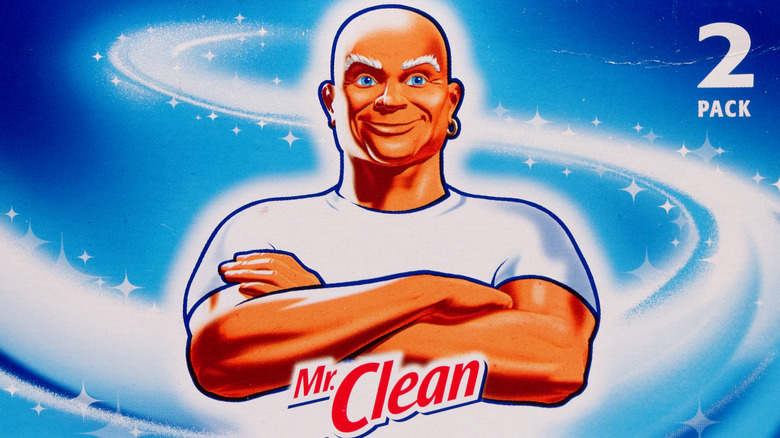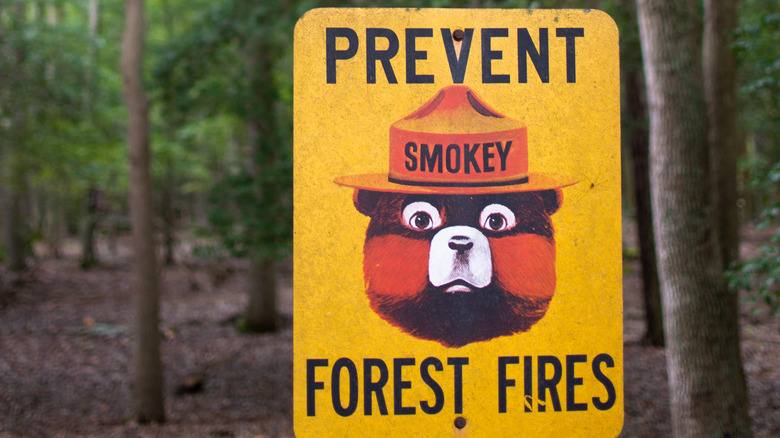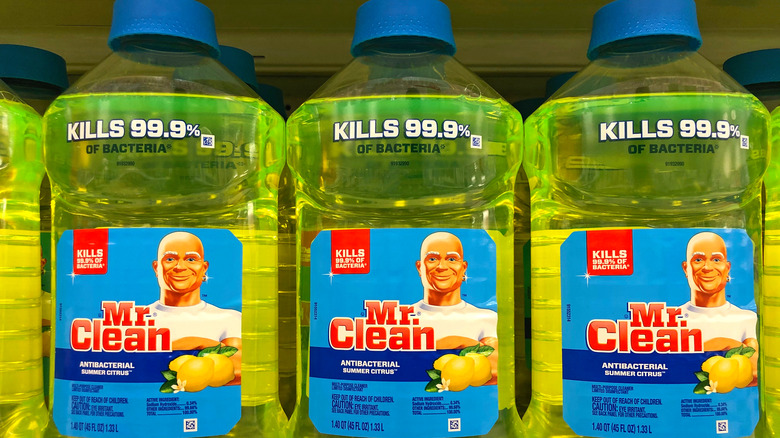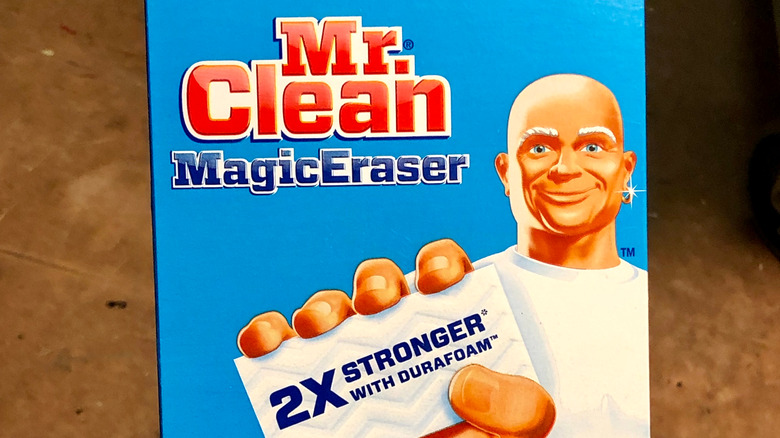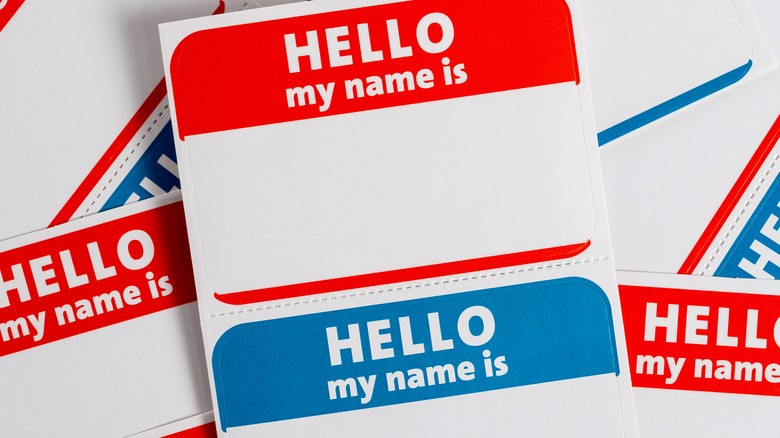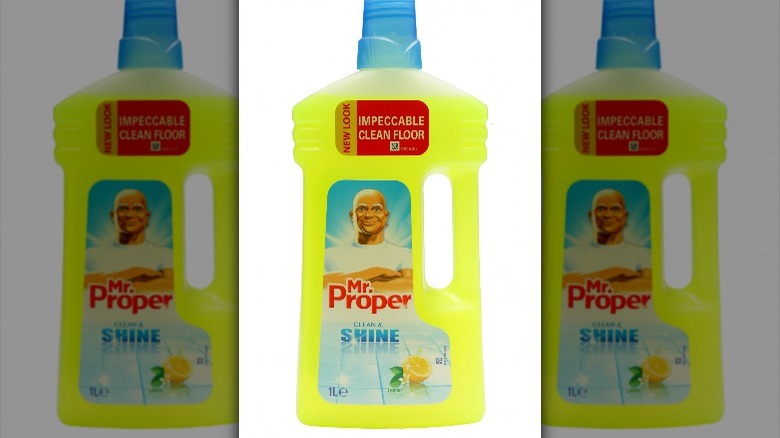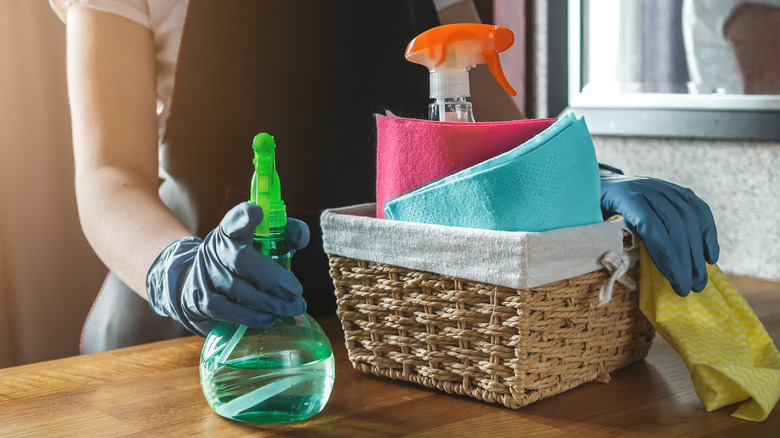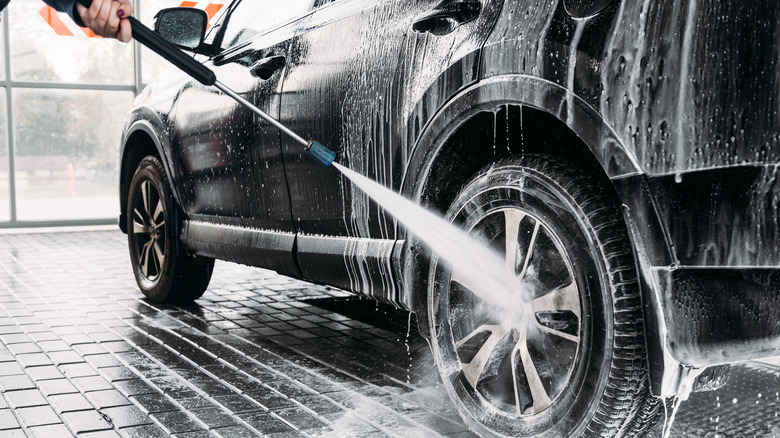The Untold Truth Of Mr. Clean
It's practically impossible to avoid this iconic mascot, whether it's in a grocery store or during commercial breaks. Mr. Clean's face appears on summer citrus-scented bottles, melamine foam sponges, and various deep cleaning mists. He's most recognized for his all-white wardrobe, bald head, hoop earring, and genie-esque charm that exudes sex appeal. It's no wonder Mr. Clean is one of the most iconic mascots, withstanding decades without altering his look.
According to Mr. Clean's website, a hardworking farmer found a baby cleaning the steps of his farmhouse and ended up raising him to become the Mr. Clean we all know and love. However, the actual story couldn't be farther from that. Not much is known about the early days of Mr. Clean, which has led his fans to speculate about his life, sexuality, and origin. It's safe to say that there are many untold stories about everyone's favorite mascot, Mr. Clean. Here are just a few.
Mr. Clean was originally designed to be used on boats
Mr. Clean was created by Linwood Burton, a marine ship cleaning businessman in the late 1950s, as per Toronto Sun. Burton held accounts all over the east coast of the United States and was running into a problem with the chemicals that were industry standard. Before Mr. Clean entered the market in the late 1950s, ships could only be cleaned with abrasive solvents designed to cut through embedded grease and grime. However, the formulas were so harsh and abrasive that they posed a danger to his employees and were a common cause of disability.
Looking for ways to avoid the premiums associated with multiple disability claims, Burton used his basic knowledge of chemistry to create a detergent-based solution that cut through the grease without relying on dangerous chemicals. The formula was much gentler and quickly found its place in the consumer market. In 1958, he sold the patent to Procter & Gamble and, soon after, the marketing wizards in the firm would come up with the Mr. Clean mascot.
Mr. Clean was supposedly based on a real U.S. Navy vet
Unlike most popular consumer brands with an extensive history, Mr. Clean has kept its mascot practically the same during its entire history. While Mr. Whipple and the Ajax pixies have come and gone, Mr. Clean has only changed his outfit in a few commercials and adapted to recent animation styles.
No one exactly knows where Mr. Clean's iconic image came from. But many believe we can thank two advertisers for his iconic charm. According to The Sitrep, in 1958, Harry Barnhart and Ernest C. Allen, employees at the advertising agency Tatham-Laird & Kudner, were tasked to create a mascot and brand image for Procter & Gamble's newest product, Mr. Clean. After scouring everywhere for inspiration, the two reportedly came across a photo of a United States Navy veteran. Barnhart and Allen immediately took inspiration from his tough exterior and bald head while also paying tribute to the product's origin story.
Mr. Clean might actually be a genie
While many people believe Mr. Clean was modeled after a sailor, others believe he was always intended to be a genie. The story goes that in 1958 Harry Barnhart and Ernest C. Allen came up with the concept of Mr. Clean but not the actual character. The agency brought in commercial artist Richard Black to conceptualize Mr. Clean. According to Black's 2014 The New York Times obituary, he submitted two renderings of a smiling genie, one with a hoop earring and the other with a nose ring. Procter & Gamble chose the hoop earring.
This theory is supported by Procter & Gamble's communications manager, Tricia Higgins, who stated that the company originally saw Mr. Clean working like magic and wanted to play on the idea that he came out of a bottle. However, in 2014, Mr. Clean tweeted that he wasn't a genie but a simple man who likes to clean.
Mr. Clean shares a connection with Smokey Bear
As it was typical for the time, Mr. Clean advertisements were hand-drawn cartoons illustrated by Tatham-Laird & Kudner's freelance cartoonist, Richard Black, as per Mel Magazine. The cartoon commercial featured a genie-like Mr. Clean who wore all white and an oversized hoop earring. Throughout the commercial, Mr. Clean is shown cleaning various products in the household, complementing his famous jingle. Although the advertisements did well, they were eventually phased out and replaced with live-action ads featuring actor House Peters Jr.
According to Inquisitr, prior to illustrating Mr. Clean, Black had his work originally published in "The Saturday Evening Post." One of his pieces caught the eye of the Department of Interior, who commissioned Black to paint Smokey Bear, a mascot created by Albert Staehle in 1944. Black's paintings were so successful he continued to draw Smokey Bear for 20 years. Black also created advertisements and mascots for Shell Oil and BankAmericard.
There's an African-American Mr. Clean
In 2016, Procter & Gamble launched an open casting call to find the biggest Mr. Clean fan who would be willing to take over his duties while he took his first vacation. According to the Cincinnati Business Courier, Kevin Wenzel, Procter & Gamble's Associate Brand Director for North America, announced the contest with the statement, "Mr. Clean has been flexing his muscles against millions of household messes since 1958, tackling dirt, grease, and grime. As you can imagine, Mr. Clean is in need of some serious R&R."
#TheNextMrClean contest was open to the North American market and received thousands of entries, each one claiming to be Mr. Clean's biggest fan. Fans were encouraged to attend open casting calls in New York and Los Angeles, or send in a 60-second audition clip. When asked what exactly they were looking for, Wenzel affirmed they wanted someone who could be "just as clean, fearless, helpful and tough on dirt as Mr. Clean."
After a long search, Procter & Gamble announced Alabama resident Mike Jackson would be Mr. Clean's temporary replacement. Jackson was the first and only African-American Mr. Clean and garnered national attention. As part of his deal, Jackson was able to star in a few Mr. Clean advertisements, receive $20,000, and an entire year's supply of Mr. Clean Magic Erasers. Jackson also fulfilled Mr. Clean's duties during the 2016 Super Bowl, and modeled for a limited edition calendar.
Magic Erasers aren't actually magic
One of Mr. Clean's best-known products is the Magic Eraser. As the name suggests, the Magic Erasers truly act like magic. They only need water to clean most stains — no chemicals or soaps necessary. The eraser looks like any other sponge from the outside, but they are so much more upon closer review. According to Grunge, Mr. Clean launched the Magic Eraser in 2003 to counteract its competitors' products, who were using harsh abrasives to cut through grease and stains. According to Martha Stewart, the sponge provides a mechanical clean rather than a chemical one, making it safer to use.
According to HowStuffWorks, what makes a Magic Eraser act like magic is the main ingredient in the product: melamine foam. As per The Daily Apple, melamine foam is a potent mixture of carbon, hydrogen, and nitrogen that was created in the 1830s to make plastics. In fact, until Procter & Gamble brought the Magic Eraser to market, one of the only common uses for melamine foam was room insulation. Even though the eraser is soft to touch, the melamine foam becomes tough when it comes in contact with a hard surface, causing it to act as abrasive sandpaper.
Mr. Clean didn't get named until 1962
Mr. Clean officially debuted on shelves in 1958, and within six months, the brand was the best-selling household cleaner in the United States, as per Toronto Sun. Despite being incredibly successful upon launch, Procter & Gamble never gave their Mr. Clean mascot a proper name. They simply didn't think he needed one since it wasn't common for mascots at the time.
According to Today I Found Out, fans of the product kept complaining to Procter & Gamble that the mascot didn't have a name. After four years, Procter & Gamble finally listened to their fans and launched the "Give Mr. Clean a First Name" contest, awarding $30,000 cash or a completely furnished house to the consumer whose name was picked (via Hunker). It also included 1,000 Motorola radios to 1,000 consumers who came in second (via WorthPoint). After some back and forth, Procter & Gamble decided on the name Veritably, which means "genuine." Making the iconic bald-headed man, Mr. Genuinely Clean.
Mr. Clean has a different name in every country
Within a few short years, Mr. Clean was on shelves worldwide, meaning the brand had to adapt to a worldwide market. According to CNBC, many famous brands change their branded names in other markets, usually due to a name already being trademarked or the original name not making sense in the country's language.
So while Mr. Clean is known as "Mr. Clean" in the United States, most of the world knows him as Mr. Proper or a translation of it. For example, Mr. Clean is known as Don Limpio in Spain, Maestro Limpio in Mexico and Puerto Rico, and Pan Proper in Poland. Because a product called Mr. Clean already exists in the U.K. and Ireland markets, the product is instead called Flash and doesn't feature the iconic mascot. But the differences don't stop there. According to HighNames, some countries even use a different jingle!
Other brands have borrowed him
While many brands avoid mingling with trademarks they don't own, there's a long line of brands willing to pay top dollar to feature Mr. Clean in their advertisements. However, Procter & Gamble is very particular with brands that are able to use Mr. Clean's iconic image and likeness, ensuring the mascot maintains his squeaky clean image.
However, in recent years, Procter & Gamble has allowed a handful of brands to feature Mr. Clean if they pay a hefty premium. According to The Wall Street Journal, in 1998, Honda paid $20 million to feature the iconic figure in an LEV Accord commercial, hoping that consumers would associate their new release with clean energy. Similarly, during the 2020 Superbowl, Adweek reported Kraft paid Procter & Gamble to use the Mr. Clean mascot during their Mr. Peanut funeral spot. Neither Kraft nor VaynerMedia, the advertising agency responsible for the campaign, has disclosed how much they paid for the brief cameo.
Mr. Clean wrote a book
To add to the timeless appeal of Mr. Clean, he had to be more than a man who loved cleaning. According to his official origin story, Mr. Clean wasn't just an orphaned farmhand who wanted to make the world a cleaner place. He's also an accomplished researcher and author.
According to the Mr. Clean website, Mr. Clean traveled the globe in a quest to become the best cleaner in history, and in order to do so, he had to conduct in-depth research. After years of gathering data, he wrote "The Encleanapedia," which eventually found its way to the desks of Procter & Gamble, where the higher-ups knew they had to hire him to shake up the cleaning industry. During special events, Procter & Gamble hands out copies of "The Encleanapedia," which is just a printout of the company's history and various cleaning tips involving its products.
Vintage Mr. Clean ads made some remarkable claims
Vintage advertisements are known for making outlandish claims, and Mr. Clean was no exception. Cincinnati Business Courier reported that as part of the Mr. Clean brand identity, Tatham-Laird & Kudner produced an iconic jingle that listed various cleaning claims. Originally sung in a duet between musicians Don Cherry and Betty Bryan, the jingle claimed Mr. Clean's all-purpose cleaner could clean everything, including a kitchen sink, a window sash, a dirty mirror, a diamond ring, and even dogs. The jingle premiered in 1958 and was met with instant success. It even became the longest-running jingle in American history.
In 2016, the same jingle was rewritten. However, the claims were changed to fit the product's modern-day uses and avoid legal liability. No longer could Mr. Clean maintain the shine on your priceless diamond ring or Fido. The product was now only recommended to clean your entire house, including all the floors, doors, walls, halls, tubs, and tiles.
In a press release, Kevin Wenzel, P&G's associate brand director for North America, said, "Having made such an impression as one of P&G's oldest and most recognized jingles, we wanted to give this uniquely ownable and relatable song a modern twist for today's consumers. Our inspiration was to renew it to bring the ear-catching tune into today's millennial households."
The E.U. has a problem with Mr. Clean
In 2008, the European Parliament pleased consumers worldwide when it voted to scold advertisers for "sexual stereotyping." According to The New York Times, Europe was being flooded with provocative advertisements targeting children and young adults during this time. While the goal to remove overly sexual images was their concern, Parliament received global backlash for the brand they were targeting: Mr. Clean, known as Mr. Proper in most European markets.
In its main argument, Parliament targeted a list of brands, including Dolce & Gabbana for using a sexual image of a group of men pinning a woman to the ground in an ad campaign. They also targeted Mr. Clean, whose overly muscular physique implied a strong man was needed to move tough stains. Parliament initially proposed a new protocol for future advertising campaigns, where brands would be publicly shamed and targeted. However, Parliament did not possess the power or gain the support to punish companies and advertising firms for sexual advertisements. Luckily for Mr. Clean, fans, and Procter & Gamble, the company was never fined or subjected to sexual stereotyping claims.
Mr. Clean is sexy to help save marriages
Mr. Clean has become rather sexual for a cartoon mascot in recent years. The shift to a sexier Mr. Clean was entirely intentional. Cynopsis Media reported that when advertising agency Leo Burnett took the Mr. Clean account, they were tasked with creating the Cleaner of Your Dreams campaign. The agency got to work analyzing the brand image, historical sales, and the North American market, and they noticed one thing that stood out amongst the data.
Dan Koutoulakis, planning director at Leo Burnett Canada, disclosed that consumers noticed an obvious sex appeal to the Mr. Clean mascot, which drove them to look at secondary research, which highlighted the unequal divide in household labor and who is primarily in charge of cleaning. Armed with their data, Leo Burnett came up with a theory: If a common issue in marriages is the lack of shared cleaning, what if Mr. Clean made cleaning sexy? Taking that direction, they created one of the sexiest advertising campaigns in recent history that went on to win the 2018 David Ogilvy Awards grand prize and Gold for Brand Transformation.
He has a little known wardrobe
Diehard fans know Mr. Clean has a classic outfit: The iconic white T-shirt and nose ring. But that isn't the only thing the muscular mascot has worn in the past few decades. According to Mental Floss, unlike most mascots, Mr. Clean has not undergone drastic changes to his image at any point in the brand's history. In fact he's only been rebranded a handful times since 1958. First, when he was moved from cartoon to live-action, then when the mascot became CGI, and once more when the brand went through a minor logo change.
For most of the brand's life, Mr. Clean wore head-to-toe white, white eyebrows, and an oversized hoop. But briefly, in the 1960s, actor House Peters Jr., who portrayed the mascot, donned a fitted black suit and tie and occasionally appeared shirtless. In recent years, CGI Mr. Clean briefly dressed as a policeman attempting to stop the evil dirt in court. Luckily for fans looking to be Mr. Clean for Halloween, Procter & Gamble has no intention to permanently change Mr. Clean's wardrobe long term.
Mr. Clean is recognized as a gay icon
While Procter & Gamble has never confirmed or denied the claim that Mr. Clean is gay, it hasn't stopped his fans from claiming him as an icon. Fans attribute the claim to the design's queer coding. In an interview with Mel Magazine, David Thorpe, director of the documentary "Do I Sound Gay?" explains, "the gay man caught up with Mr. Clean and he was kind of grandfathered in. Mr. Clean's got the bald head and the strong eyebrows; he's buff, well-groomed, has a pierced ear, loves to clean, and wears tight clothing, so he checks a lot of boxes."
Procter & Gamble representatives claim that Mr. Clean's sexuality is one of the most common questions they get. However, the brand refuses to make an official statement, telling Salon, "We've been receiving questions like that for at least the past 10 years. We're not sure where it started, it could have to do with his earring or his attire, but we like to think Mr. Clean was just a man before his time."
You can own a Mr. Clean franchised car wash
When you think of automobile cleaning, Mr. Clean usually isn't the first name that pops into your head. However, the folks at Mr. Clean want to change all that. According to TheMrCleanCarWash on YouTube, in 2011, Proctor & Gamble joined forces with their franchising division, Agile Pursuits, to combine the Mr. Clean fanbase with the growing auto care market.
To recruit franchise owners, Proctor & Gamble offers owners an array of quality products, support, unique marketing expertise, and Mr. Clean's instant brand recognition. The Mr. Clean Car Wash differentiates itself from its competitors by focusing on seven key areas of your car, ranging from oil changes and maintenance services, cleaning your car's interior, spot cleaning wheels, and shining the body and hood (via Mr. Clean Car Wash). It also recycles and filters all the water it uses in its operations. The branded car wash is currently available in Georgia and Florida and is coming soon to Knoxville, Tennessee.
Drivers with Mr. Clean Car Washes in their area can also purchase a monthly unlimited package (via Mr. Clean Car Wash). This grants them access to a lounge area where they can watch TV and help themselves with complimentary coffee while waiting for their car to be cleaned. Fans can pick between four different plans that fit their needs.
Magic Erasers really can clean almost anything
In some of the earliest Mr. Clean advertisements, the original product claims to clean a whole laundry list of items. According to Ideas for the Home, the Mr. Clean Magic Eraser can do just about anything. Melamine foam, the main component of Magic Erasers, is known for its property of being a mild abrasive and being able to cut through difficult stains and grease.
The site claims there are at least 100 uses for Mr. Clean's Magic Eraser. For example, the sponge can clean grout and make it look like new. It can also remove hairspray on hard surfaces or soap scum from tubs, showers, and shower doors. The eraser can also clean cookie sheets and other bakeware, as well as built up lime and hard water on dish drains and dishwashers. Mr. Clean's Magic Erasers can also remove tarnish from silver, making it perfect for polishing silverware and silver jewelry.
Parents of young children will also be excited to learn that Mr. Clean can remove paint from door hinges and light-colored carpets, as well as any marks on walls. Pet owners should also note that the Magic Eraser can remove pet nose marks from virtually any surface, including windows, doors, door frames, and mirrors. The sponge can even remove stains on concrete surfaces, including counters and sidewalks.
